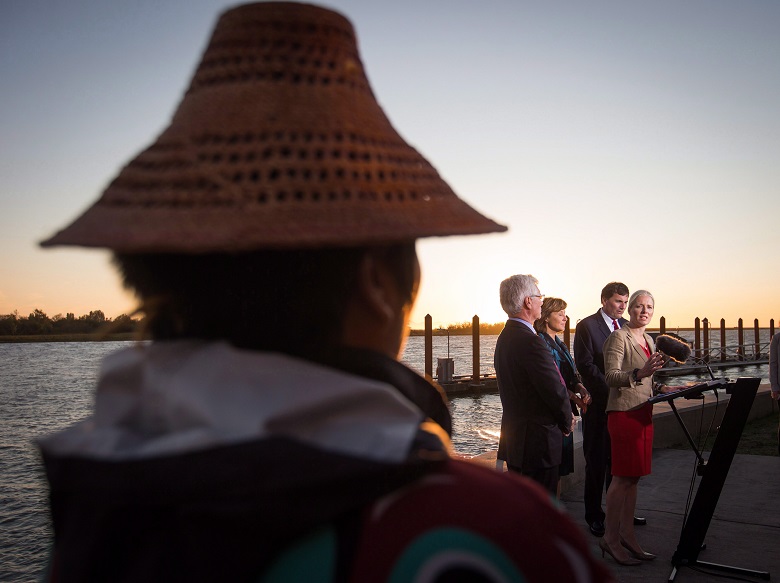Less than a year after the federal government gave the green light to a new liquefied natural gas project in British Columbia, the companies behind the ambitious plan have pulled the plug.

Pacific NorthWest LNG (or PNW LNG) may eventually be replaced by something else with the same backers, but in its current form — the form approved by Ottawa last fall — it’s dead.
So what killed the project? And who will benefit, or lose out, now that it’s no longer moving ahead?
Supply and demand
The companies behind PNW LNG, the biggest of which was Malaysian oil and gas giant Petronas, said their troubles boiled down to economics. Simply put, there isn’t enough demand for liquefied natural gas in North America and abroad, while the global supply has only increased.
READ MORE: $36-billion Pacific NorthWest LNG project dead
To understand why the numbers didn’t add up, you need to go back over a decade. At that point, the prospects for LNG production and import to the United States, in particular, looked rosy.
But around 2008, there was a surge in unconventional natural gas production (mostly from shale gas) in the U.S., and importing LNG to American markets started to make a lot less sense.
WATCH: Pacific NorthWest LNG project dead

As North American prices plummeted, companies began examining the possibility of reversing the flow — instead exporting LNG to hungrier foreign markets. Australia and the United States jumped at that chance, approving multi-billion-dollar facilities with gusto.
The export facility proposed in British Columbia would have produced up to 19.2-million additional tonnes of LNG a year, but it may have come too late.
For comparison, a total of 244.8-million tonnes of LNG was produced and shipped globally in 2015. The Canadian project would have added significantly to that tally. Global demand, meanwhile, is still not growing as fast as needed to justify increased supply, particularly in Asian markets.
READ MORE: Cancelled liquid natural gas project in B.C. will have ripple effect in Alberta
Last week, the National Energy Board (NEB) issued a less-than-glowing assessment of Canada’s efforts to move ahead on LNG projects, noting that we’ve been outpaced by fierce global competitors who already have pipelines and terminals set up.
The ill-fated PNW LNG now joins a list of stymied Canadian ventures. The Shell-led LNG Canada project, which would have been built near Kitimat, B.C., was indefinitely delayed in July 2016. AltaGas Ltd. also shelved its smaller Douglas Channel LNG project in February 2016.
“Woodfibre LNG near Squamish, B.C., is the only Canadian project where the company has reached a final investment decision to proceed,” the NEB noted.
Political decision?
The B.C. Liberals, fresh off their shift to the opposition benches in the province, say market forces are only partly to blame. They are also pointing the finger at the NDP government, saying it has created a political climate that was inhospitable to the LNG mega-project.
Backed by the Greens, who were staunchly opposed to the Pacific NorthWest plan, the NDP had voiced significant concerns in the past. The party is generally perceived as much less receptive to anything that could contribute to increased carbon emissions.
“Today, you have an energy minister who has made disparaging remarks about LNG when they were in opposition,” said B.C. Liberal MLA Jas Johal in a video statement, adding that new Premier John Horgan sent a letter to Ottawa opposing the project before forming government.
Federal Conservative leader Andrew Scheer chimed in Wednesday, blaming federal Liberal policies for creating an inhospitable environment.
Still, Petronas board chairman Anuar Taib assured everyone on Tuesday that the recent change in government in B.C. did not factor into the decision to kill PNW LNG.
Who loses?
The biggest losers are arguably British Columbians who may have benefited from the short- and long-term economic activity surrounding the new export facility.
The construction phase was supposed to create 4,500 jobs, for instance, and then another 300 to 400 people were expected to be employed at the export plant once it was operational.
READ MORE: Disappointment on B.C.’s north coast as Pacific NorthWest LNG scrapped
In Port Edward, the community nearest to where the plant would have been located, the loss was described as personal.
“I am disappointed. I’d hoped it would go forward,” Mayor Dave MacDonald told Global News.
Who wins?
Environmental activists are ecstatic, calling the project’s cancellation a “massive win” on Tuesday, and citing the additional emissions it would have created. The planned terminal had also drawn criticism from some First Nations groups because of its potential impact on salmon in the Skeena River, and was facing several court challenges.
The Pembina Institute issued a release applauding the decision, calling it “an important opportunity to ensure B.C. is not left behind as the global economy shifts and the costs of a changing climate begin to mount.”
— With files from The Canadian Press, Simon Little and Emily Lazatin




Comments